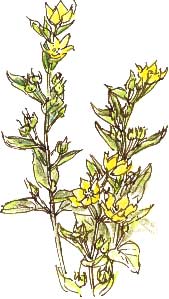 |
Yellow LoosestrifeThursday, 8th August 2002, West Yorkshire |
![]()
![]()
![]()
![]() Rocks |
History |
Workshop |
Links |
Home Page
Rocks |
History |
Workshop |
Links |
Home Page
![]()
 Loosestrife is said to have been given its Latin name, Lysamachia, after King Lysimachos (355-280 B.C.) King of Thrace and general to Alexander the Great, who is said to have used a piece of it to pacify a bull. But the loosestrife tag might be the result of mistranslation; its Greek name lusimakhion (after Lysimachos) being confused with lusimakhos; 'ending strife'.
Loosestrife is said to have been given its Latin name, Lysamachia, after King Lysimachos (355-280 B.C.) King of Thrace and general to Alexander the Great, who is said to have used a piece of it to pacify a bull. But the loosestrife tag might be the result of mistranslation; its Greek name lusimakhion (after Lysimachos) being confused with lusimakhos; 'ending strife'.Pliny (23-79 A.D.) believed it had soothing effect on oxen and that the plant helps keep flies and gnats at bay.
Yellow Lysimachus, to give sweet rest To the faint shepherd, killing, where it comes, All busy gnats, and every fly that hums.
John Fletcher, The Faithful Sheperdess, 1610
It certainly has a soothing effect on me as I sit drawing it by the pond after a day of errands. It is a native wild flower in Britain but we've planted it here by the pond.The Murmuring Stream
I've just finished reading Frederick Turner's biography of John Muir. In the final pages Turner suggests parallels between Muir's wilderness experience in Yosemite and Zen enlightenment.A monk once asked Zen master Gensha how to enter upon the path of truth; 'Do you hear the murmuring stream?' replied Gensha, 'There is a way to a way to enter.'
Turner quotes Tozan, who began his enlightenment with 'his understanding of the teachings of inanimate things';
Marvellous! Marvellous!
How mysterious the Inanimate-Teaching!
It is difficult to hear with the ears:
When we hear with the eyes, then we know it!
![]()
Richard Bell,
wildlife illustrator
E-mail; 'richard@willowisland.co.uk'
![]() Next page |
Previous page |
This day last year |
This month
Nature Diary |
Home Page
Next page |
Previous page |
This day last year |
This month
Nature Diary |
Home Page
![]()